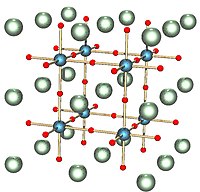
Photo from wikipedia
Although metal-halide perovskites have recently revolutionized research in optoelectronics through a unique combination of performance and synthetic simplicity, their low-dimensional counterparts can further expand the field with hitherto unknown and… Click to show full abstract
Although metal-halide perovskites have recently revolutionized research in optoelectronics through a unique combination of performance and synthetic simplicity, their low-dimensional counterparts can further expand the field with hitherto unknown and practically useful optical functionalities. In this context, we present the strong temperature dependence of the photoluminescence lifetime of low-dimensional, perovskite-like tin-halides and apply this property to thermal imaging. The photoluminescence lifetimes are governed by the heat-assisted de-trapping of self-trapped excitons, and their values can be varied over several orders of magnitude by adjusting the temperature (up to 20 ns °C−1). Typically, this sensitive range spans up to 100 °C, and it is both compound-specific and shown to be compositionally and structurally tunable from −100 to 110 °C going from [C(NH2)3]2SnBr4 to Cs4SnBr6 and (C4N2H14I)4SnI6. Finally, through the implementation of cost-effective hardware for fluorescence lifetime imaging, based on time-of-flight technology, these thermoluminophores have been used to record thermographic videos with high spatial and thermal resolution.Low-dimensional tin-halide perovskites exhibit strong temperature dependence of luminescence decay time that translates into high sensitivity over a wide range of temperatures and as such can be used in high-resolution remote thermography.
Journal Title: Nature Materials
Year Published: 2019
Link to full text (if available)
Share on Social Media: Sign Up to like & get
recommendations!